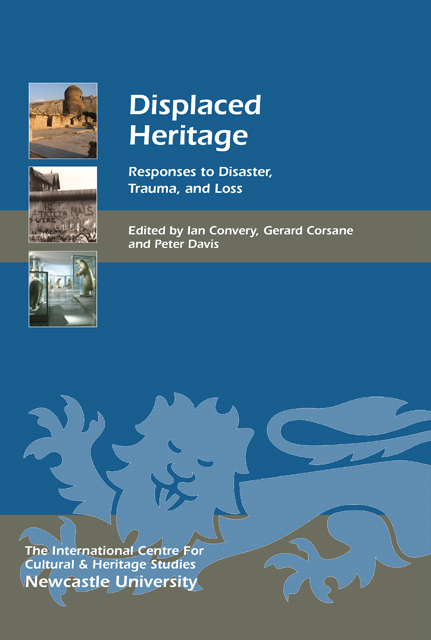Book contents
- Frontmatter
- Contents
- List of Illustrations
- Acknowledgments
- List of Abbreviations
- Preface
- Introduction
- Displaced Heritage: Histories and Tourism
- Displaced Heritage: Trauma, Confinement and Loss
- Displaced Heritage: Lived Realities, Local Experiences
- Displaced Natural Heritage
- Endpiece
- List of Contributors
- Index
- Heritage Matters
13 - The Last Night of a Small Town: Child Narratives and the Titanic
Published online by Cambridge University Press: 24 February 2023
- Frontmatter
- Contents
- List of Illustrations
- Acknowledgments
- List of Abbreviations
- Preface
- Introduction
- Displaced Heritage: Histories and Tourism
- Displaced Heritage: Trauma, Confinement and Loss
- Displaced Heritage: Lived Realities, Local Experiences
- Displaced Natural Heritage
- Endpiece
- List of Contributors
- Index
- Heritage Matters
Summary
Introduction
The story of the Titanic – its construction, its sinking on 14 April 1912 and the discovery of the wreck in 1985 – is one whose worldwide appeal was amply demonstrated by the flood of new books and television documentaries on the 100th anniversary in 2012. This chapter engages with the theme of displaced heritage by reflecting on the process of writing my own book on the subject and by exploring what we might term ‘re-narrated heritage’ (Welshman 2012). One of my original premises was the belief that in the recent emphasis on myth, and on the causes of the disaster, the focus on individual passengers and crew members, and their stories, had been lost (Howells 1999). What seemed to me most interesting were the personal narratives of both passengers and crew, and the light that the human detail of their stories sheds on the worlds they came from. The book was conceived as a trade book, a popular narrative that depicts the disaster through the personal stories of 12 people. I chose my 12 as a cross section of those on board my ‘small town’ (Lord 2005, 153). In that respect the 2012 book’s approach is similar to that of my previous book on the experiences of wartime evacuees (Welshman 2010). The book covers the stories of passengers and crew and reconstructs individual experiences, as well as surveying broader social changes. I felt the small town metaphor was helpful in conveying the sense that all aspects of society were on the ship: rich and poor, male and female, old and young, generous and selfish. The book seeks to rebalance the passengers and crew depicted in Walter Lord’s book of 1955; employs a ‘life history’ approach to uncover the lives of these people before and after the disaster; and aims not just to offer a minute-by-minute retelling of events, but also to explore key themes – the construction of the ship; migration; nationality and place; the wider histories of technology and radio; age and gender; and social class.
The book thus weaves the stories of 12 passengers and crew into the narrative. These narratives can be grouped into three types: those published shortly after the disaster, in the interwar period, and much more recently. Moreover, they present a range of challenges to the historian who attempts to use them.
- Type
- Chapter
- Information
- Displaced HeritageResponses to Disaster, Trauma, and Loss, pp. 143 - 150Publisher: Boydell & BrewerPrint publication year: 2014



